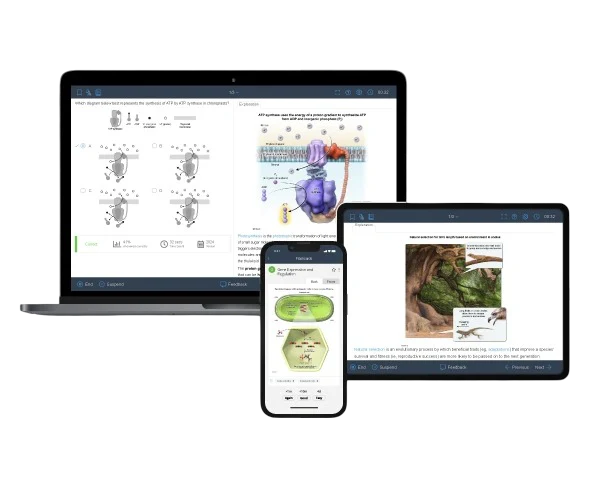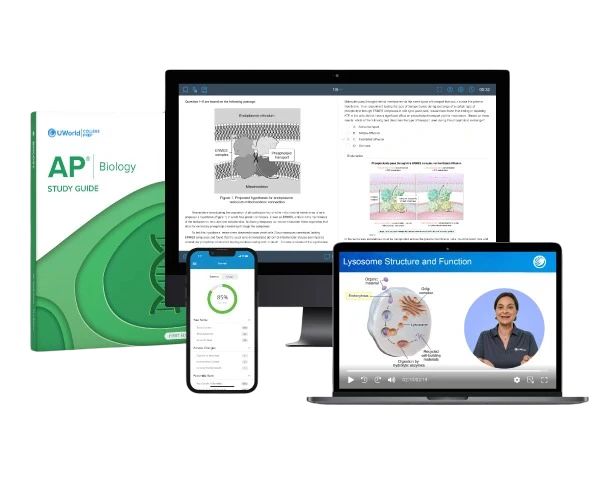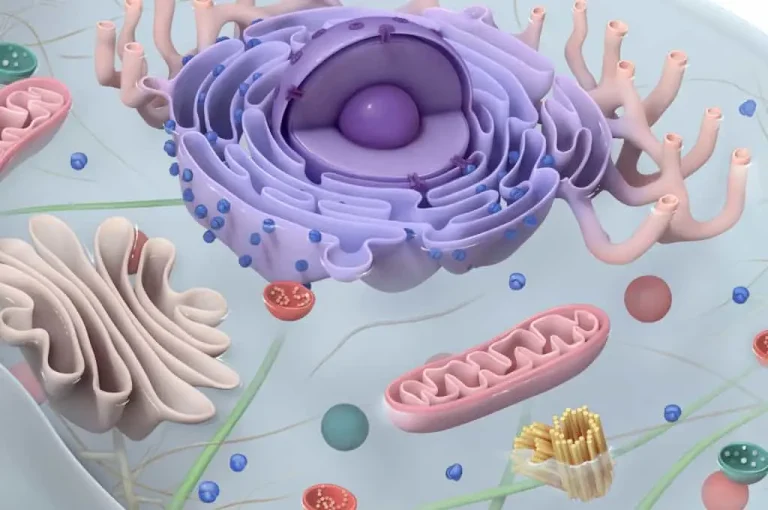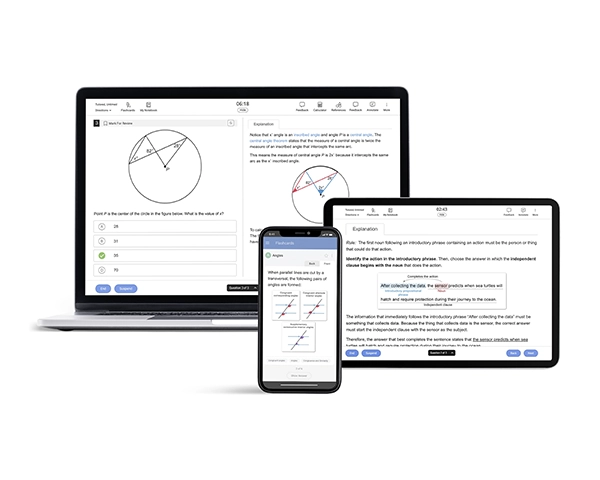The AP® Biology exam requires more than just memorization — you need to understand how to apply formulas to solve biological problems. The exam includes quantitative questions that test your ability to analyze data, perform calculations, and interpret scientific models. That’s where our AP Biology formula sheet comes in. This resource provides key equations and constants to help you during the exam, ensuring you can focus on problem-solving rather than recalling formulas from memory.
Key Formulas and Equations on the AP Biology Formula Sheet
Mastering these formulas will help you tackle AP Biology exam questions. Know when and how to apply them so you can accurately analyze biological systems.
Water Potential Equation (Ψ = Ψs + Ψp)
Water potential measures the tendency of water to move from 1 area to another. This concept is important for understanding osmosis in plant cells. The equation includes solute potential (Ψs), which depends on solute concentration, and pressure potential (Ψp), which accounts for physical pressure.
Example Problem: A plant cell has a solute potential of -3.0 bars and a pressure potential of 1.0 bar. What is its total water potential?
Solution: Ψ = Ψs + Ψp = (-3.0) + (1.0) = -2.0 bars.
Hardy-Weinberg Equilibrium Equation
The equations p² + 2pq + q² = 1 and p + q = 1 help determine the genetic makeup of a population under equilibrium conditions. By using allele frequencies, you can analyze how genetic variation remains constant unless influenced by evolutionary forces.
Example Problem: If a population has a dominant allele frequency (p) of 0.6, what is the expected frequency of homozygous recessive individuals (q²)?
Solution: q = 1 - p = 1 - 0.6 = 0.4. q² = (0.4)^2 = 0.16 (or 16%).
Chi-Square Analysis (χ² = Σ[(O – E)² / E])
The chi-square test is used in genetics to determine whether observed results differ significantly from expected values. This formula is essential for understanding inheritance patterns and predicting phenotypic ratios in genetic crosses.
Example Problem: A genetic cross results in 80 red flowers and 20 white flowers. The expected ratio is 3:1. Does this data support Mendelian inheritance?
Solution: Use χ² to compare observed vs. expected values and determine statistical significance.
Rate of Population Growth (dN/dt = rN)
This equation models how populations grow over time. The exponential model applies when resources are unlimited, while logistic growth accounts for environmental limits and carrying capacity.
Example Problem: If a population of 100 bacteria has a growth rate of 0.2 per hour, how many bacteria will be present after 1 hour?
Solution: dN/dt = rN = (0.2)(100) = 20 new bacteria, for a total of 120.
Photosynthesis & Cellular Respiration Equations
Photosynthesis and cellular respiration drive energy flow in ecosystems:
- Photosynthesis: 6CO₂ + 6H₂O → C₆H₁₂O₆ + 6O₂ (captures energy from sunlight to synthesize glucose)
- Cellular Respiration: C₆H₁₂O₆ + 6O₂ → 6CO₂ + 6H₂O + ATP (breaks down glucose to release usable energy)
Example Problem: If a plant absorbs 24 CO₂ molecules, how many glucose molecules can it produce?
Solution: 24 CO₂ molecules / 6 CO₂ per glucose = 4 glucose molecules.

pH and pOH Calculations (-log[H+])
pH measures acidity, while pOH relates to basicity. These calculations are essential in enzyme function and biochemical reactions.
Example Problem: If an acid has an H+ concentration of 1.0 x 10⁻⁴ M, what is its pH?
Solution: pH = -log(1.0 x 10⁻⁴) = 4.
Energy Transfer & Gibbs Free Energy (ΔG = ΔH – TΔS)
This formula determines whether a reaction occurs spontaneously.
Example Problem: If ΔH = -100 kJ, T = 298K, and ΔS = 0.3 kJ/K, what is ΔG?
Solution: ΔG = (-100) - (298)(0.3) = -189.4 kJ (spontaneous reaction).
Statistical analysis and probability
Biological research relies on statistical tools to analyze experimental data. Key calculations involve standard deviation, standard error, and probability tests to determine the reliability of results.
Metric Prefixes
Understanding metric prefixes (milli-, micro-, nano-, etc.) ensures accuracy in unit conversions, a skill tested frequently in AP Biology questions.
Example Problem: Convert 5.0 millimeters (mm) to micrometers (μm).
Solution: Since 1 mm = 1,000 μm, 5.0 mm = 5.0 × 1,000 = 5,000 μm.
Simpson’s Diversity Index
This formula quantifies biodiversity in an ecosystem, helping scientists compare species richness and evenness across different environments.
Example Problem: If an ecosystem contains 4 species with the following counts: Species A (10), Species B (20), Species C (30), and Species D (40), calculate Simpson’s Diversity Index.
Solution: Use the formula D = 1 - (Σ(n/N)²). By plugging in the values, you can determine the ecosystem's diversity score.
Other Essential Formulas
Dilution Equation (C₁V₁ = C₂V₂): Used in lab experiments to prepare solutions of desired concentrations.
Surface Area-to-Volume Ratio: Explains why cells are small. Higher ratios allow efficient exchange of materials.
Q10 Temperature Coefficient: Measures how reaction rates change with temperature shifts.
Net Primary Productivity (NPP = GPP - R): Calculates energy available for consumers in an ecosystem.
5 Tips to Effectively Use the AP Biology Formula Sheet
Mastering the AP Biology equation sheet isn’t just about memorization — it’s about using it strategically on the exam.
Tip 1: Focus on Understanding and Application
Instead of rote memorization, practice using each formula in context. Apply them in lab experiments, practice problems, and data interpretation exercises. The more you work with these formulas in real scenarios, the easier they’ll be to recall and use on the exam. Breaking down formulas into components and understanding their biological significance will also reinforce comprehension.
Tip 2: Practice AP Biology Problem-Solving Questions
Use past AP Biology exam questions to see how formulas are applied in different contexts. Solve problems that require interpreting data from experiments, graphs, and statistical analyses. Work on identifying which formulas to use in various scenarios, as this skill is crucial for efficiency during the test. The more you practice, the more confident you will become in applying the correct formula under timed conditions.
Tip 3: Avoid Common Mistakes
Common mistakes include misusing units, misplacing decimal points, or incorrectly interpreting the meaning of a formula. Make sure your calculations align with what’s biologically possible. If an answer seems unrealistic, go back and identify potential miscalculations. Practice with different types of questions to recognize where errors commonly occur and develop strategies to avoid them.
Tip 4: Manage Your Time
Familiarize yourself with the formula sheet before exam day to quickly locate key equations. During practice tests, set a timer to mimic exam conditions and refine your ability to efficiently use the AP Biology equation sheet under pressure. Prioritize solving simpler problems first to maximize time for more complex calculations later in the exam.
Tip 5: Familiarize Yourself With the Calculator
Your scientific calculator is a powerful tool for AP Biology. Get comfortable using logarithmic functions, statistical calculations, and exponents, as these are commonly required for solving AP Biology problems. Practice using your calculator in combination with the formula sheet to develop a smooth workflow for solving complex equations quickly and accurately.

Frequently Asked Questions
Do I need to memorize all the formulas for the AP Biology exam?
Where can I download the official AP Biology formula sheet?
How do we calculate degrees of freedom in AP Bio?
Read More Related Articles
Learn about the AP Biology exam structure, topics, and question types to develop a strong study strategy.
AP Biology CEDExplore the AP Biology Course and Exam Description (CED) to understand unit breakdowns and learning objectives.
How to Study for AP BiologyGet expert tips on structuring your study schedule, using effective resources, and mastering difficult topics.
How to Self-Study for AP BiologyFind out how to independently prepare for the AP Biology exam, from selecting study materials to taking practice tests.
Best AP Biology Study Guide ComparisonCompare top AP Biology study guides to find the best fit for your learning style and exam goals.
Best AP Biology Prep Course ReviewExplore in-depth reviews of AP Biology prep courses to determine which one offers the most effective test preparation.



